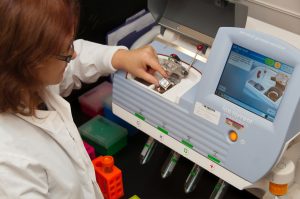The Truth About Colloidal Silver Particle Size
The smaller the particles in colloidal minerals, the more effective the product. As a result, many producers make claims about the small colloidal silver particle size in their products, but rarely are the particles found to be as small as claimed.
Comparing The Size Report to The Product Size Claims

Colloidal Science Laboratory (CSL) has created a variety of size reports for various silver products.
When examining the Complete Size Reports and comparing the measured values of particle size to the claims made by colloidal silver producers, it quickly becomes apparent that the size claims are greatly exaggerated.
Most ionic silver products have been found to contain particles in the 10 to 100 nm range. Silver protein products typically contain extremely large particles in the 2000 to 10,000 nm range (2 – 10 microns).
The most egregious exaggerations are found among the silver protein products. Some contain particles that are up to 1000 times larger than their producers claim.
Examples Of Exaggerated Colloidal Silver Particle Size Claims
In every case, the actual size of the particles is significantly different than the size claimed (ranging from 9 times larger to 829 times larger and even 1500 times larger!!!) Keeping in mind that particle size is the most significant determinant of product effectiveness, these deviations are of critical importance.
Click here for a Size Report of a silver protein product that claims to have a particle size of 10 nm. Notice that the size of the majority (64%) of the particles are 8292 nm ( 829 times larger than claimed ).
Click here for a Size Report of another silver protein product claiming: The particle size of our Colloidal Silver ranges between 0.004 and 0.107 microns, with over 75% measuring between 0.065 and 0.013 microns in diameter. * Notice that the size of the majority (64%) of the particles is 6185 nm (57-1500 times larger than claimed).
Click here for a Size Report of an ionic silver product claiming: Particle Size: The smaller the silver particle size (0.001-0.0005 microns or less), the more effective the product. Our silver particles are the smallest of all brands tested. Notice that the size of the majority (93%) of the particles is 19.92 nm (20-40 times larger than claimed).
Here is the Size Report of an ionic silver product claiming: Particle size as 0.0008 microns. Notice that the size of the majority (82.9%) of the particles is 8.23 nm (10 times larger than claimed).
Why Is Particle Size Important?
The effectiveness of a colloid is predicated on the particle surface area. Particle size is one of the two main factors that determine the particle surface area of a colloid.
Smaller particle sizes are more desirable because of the smaller the particles, the greater the particle surface area. Some products contain particles that are smaller than 1 nanometer.
How To View The Particle Size Distribution Reports
For each product that is tested and reported in the Product Reports section, there is a detailed laboratory analysis page that can be viewed by clicking on the product name in the comparison table. At the bottom right side of the Commercial Product, Report page is a link to the Complete Size Report.
The size reports were generated by either of two instruments; a Zetasizer or a High-Performance Particle Sizer (HPPS). The reports generated by the Zetasizer consist of two pages while the HPPS report is a single page.
For Zetasizer reports, the relevant information is the Peak Analysis by Volume which is on page two. For reports generated by the HPPS, the size information is displayed in the Results section followed by a graphical size distribution plot.
The Colloid Surface Area table shows the relationship of particle surface area as a function of concentration (ppm) and particle size (nm). In order to calculate the particle surface area of a colloid, the particle size distribution must first be determined.
The details of the particle size distribution is presented in the Complete Size Report as part of the laboratory analysis that is performed for the Product Reports published on this web site.

About CSL Size Reports
Because the equipment required to measure colloid particle size distribution is very specialized and expensive, only certain laboratories that specialize in measuring the physical properties of colloids will be able to determine the size of the particles found in these products.
The producers that sell the products do not possess the required equipment and it would seem that they count on the fact that the buying public has no way to determine the size of the particles in products they purchase. Very few laboratories can actually make such measurements.
The Colloidal Science Lab (CSL) is one of only a few labs in the country that is equipped to accurately measure the particle size distribution of colloidal particles. CSL performs the lab analysis of products that are published on this web site.
Related Information
- How to Compare Colloidal Silver Products
- Particle Surface Area and Effectiveness
- Bioavailability of Colloidal Silver
- The Truth About Covalent Silver
- The Truth About Ionic Silver
- The Myth of Monatomic Colloidal Silver
- The Truth About Silver Protein Products
- The Truth About TEM Images of Ionic Silver Solutions
- Bacteriology Studies of Ionic Silver are Bogus
- Bogus Scientific Claims Made for Ionic Silver Products
- Bogus Scientific Claims Made for Silver Protein Products
- Find colloidal silver products on the internet

